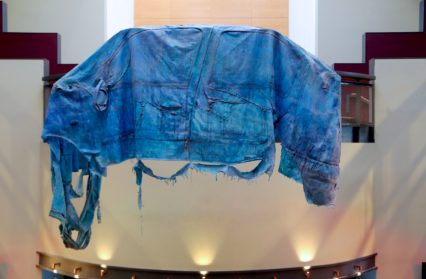Andrew Smith examines the powerful new exhibition by Eli Acheson Elmassry at the Galeri, Caernarfon.
There is intense focus in the constituent parts of the visual orchestration of the new exhibition by Eli Acheson-Elmassry at Galeri, Caernarfon. It creates for the viewer an immersive experience exploring the memory of her mother’s Alzheimer’s disease over a number of years. Through multiple process methods using made, moulded and appropriated materials utilising installation, sculpture and particularly, collaboration with sonic and performance artists, we are invited to enter an unsettling, poetic and highly sensory journey.
We enter the gallery to be immersed in sheets of blue, Mum’s Bedding envelops us sail like across the space. To the left is Anger Pantry and to the right, part of the Walking Mum, the striking costume worn by collaborating artist Wanda Zyborska; it contains a deep blue in the fabrics, a religious reference in the long trail piece indicating metaphor for multiple personal identities.
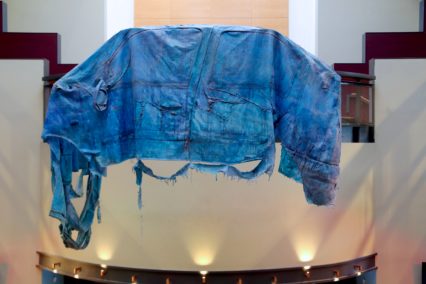 We then move through to video projection, further costume and out into the wider centre space of Galeri for suspended sculpture and table sound works interacting with all areas of the public art centre and creating an expansive orchestration of visual art working outside of the limits of the gallery. As with all Acheson-Elmassry’s work there are several meanings interweaving through the constituent areas of the creative work. Reflecting on personal memories of her mother, Acheson-Elmassry has shifted the personal to incorporate subject frameworks of the Alzheimer’s disease, memory, identity and time. The methodology is to evoke focused details of the subject through discrete pieces that as a whole, unify to form a recollected tableaux of majestic domesticity. The everyday becomes an ethereal dreamlike representation of a life whilst engaging the viewer with actualities of the demise of character with the onset of Alzheimer’s disease. The everyday acts of washing, cooking, attending church and driving are facets of the ordinary, essentially overlooked routines of daily life and household management. These in turn are gradually overturned by the disease and elements of our perceptions of normality become increasingly disengaged from reality and enter an oblique area of unchartered human expression. Engagement here is with the out-of-ordinary and pans, piano and pantry become objects and places of an unsettling imagination as we come to terms with an idea of the symptoms triggered by the onset of the disease.
We then move through to video projection, further costume and out into the wider centre space of Galeri for suspended sculpture and table sound works interacting with all areas of the public art centre and creating an expansive orchestration of visual art working outside of the limits of the gallery. As with all Acheson-Elmassry’s work there are several meanings interweaving through the constituent areas of the creative work. Reflecting on personal memories of her mother, Acheson-Elmassry has shifted the personal to incorporate subject frameworks of the Alzheimer’s disease, memory, identity and time. The methodology is to evoke focused details of the subject through discrete pieces that as a whole, unify to form a recollected tableaux of majestic domesticity. The everyday becomes an ethereal dreamlike representation of a life whilst engaging the viewer with actualities of the demise of character with the onset of Alzheimer’s disease. The everyday acts of washing, cooking, attending church and driving are facets of the ordinary, essentially overlooked routines of daily life and household management. These in turn are gradually overturned by the disease and elements of our perceptions of normality become increasingly disengaged from reality and enter an oblique area of unchartered human expression. Engagement here is with the out-of-ordinary and pans, piano and pantry become objects and places of an unsettling imagination as we come to terms with an idea of the symptoms triggered by the onset of the disease.
Video is utilised both as documentary of the performance work by Wanda Zyborska and as a medium for a large scale projection work Discord – Collapse of Mum in the main gallery space. In this work shoreline ebb and flow engulfs a sculptural form moulded from mothers’ piano referencing the beach that Acheson-Elmassry remembers was important to her mother as a place to go and collect seaweed for the garden. The video is projected large scale onto the gallery wall in diffused light adding a sense of recollection of the light and space of Newborough beach. The washing back and forth of the sculptural form in the water symbolising perhaps, the effects of time on remembrance, the ebb and flow of change and also displacement. This is a potent work as the pliable form is moved by the water fusing with the sand, continually mutating and transformative.
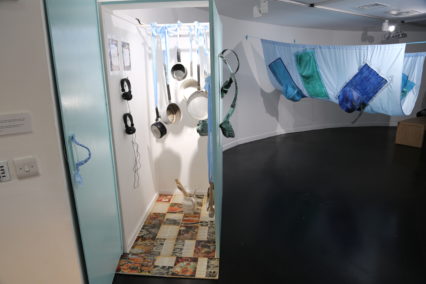 Colour as an expressive medium for Acheson-Elmassry continues into Anger Pantry with metallic greens shining from the bodywork of her mother’s car here formed into pans that we are invited to bang and create sonic expression via electro-acoustic composer Huw McGregor’s collaboration work featuring a large range of melodic sounds instantly inviting orchestrating and composition in the viewer; this sound against that one and then this. For a minute, we compose whilst reflecting on the banging pans that became part of mother’s routine under Alzheimer’s disease. Transformation of the memory of an alarming action into a poetic and expressive work whilst contained in the restrictive pantry space is indicative of heightened almost conflicting emotional states.
Colour as an expressive medium for Acheson-Elmassry continues into Anger Pantry with metallic greens shining from the bodywork of her mother’s car here formed into pans that we are invited to bang and create sonic expression via electro-acoustic composer Huw McGregor’s collaboration work featuring a large range of melodic sounds instantly inviting orchestrating and composition in the viewer; this sound against that one and then this. For a minute, we compose whilst reflecting on the banging pans that became part of mother’s routine under Alzheimer’s disease. Transformation of the memory of an alarming action into a poetic and expressive work whilst contained in the restrictive pantry space is indicative of heightened almost conflicting emotional states.
The poetry and beauty in this exhibition is achieved through the medium used in each piece. Acheson-Elmassry’s signature sculptural works use soft, pliable latex 3D forms often moulds or casts that are used to activate a space through colour, scale and placement. In the main reception area of the gallery high up and suspended ghost like and mid-air, InAutomobile recalls the moment of breaking the news to mother that she could no longer drive. The Renault became a symbol of independence that within the grip of the disease became a visual reminder of debilitation. Through a single mould in pliable deep green latex (and inside blue green) the entire Renault car becomes a symbol of immobility, a relic, the journey to shop and church now gone and in memoriam. InAutomobile floats above our heads like a ghost of conspicuous absence, a metaphor for the absent journey. The evocation in the work is of a dreamlike encounter, a passing moment in the exhibition’s tableaux.
Colour is essential to the meaning of Acheson-Elmassry’s work. In the process of taking moulds from actual objects, colour separates the work from the original and locates it as sculptural form, less facsimile more metaphor. Mum’s Bedding is an expansive piece straddling the main gallery with two sail like forms of blue poly cotton sweeping across the space and creating two horizontal concave shapes evocative of a fresh breezy washing day. Stitched into the blue areas of cotton are latex moulds of the kitchen sink in various hues of greenish blue, ultramarine and azure with applications of later acrylic colour. The sinks are repeated metaphors of the everyday. They are recognisable and this accessibility becomes intrinsic when stitched into the sheets as floating relics; they hang in the end weighty, semiotic definition for the daily grind of the role of the domestic woman. Acheson-Elmassry emphasises the formal qualities of the work; scale, colour and texture and above all process; mould, sew, cut and construct. At the same time she activates the work with a lively freshness to the quality of making that celebrates the differences by oblique reference to the original form. The recognition of the original form is intrinsic to the poetry of the work; recognition underlying the sensory perception. Recurring colours feature throughout the exhibition; the memory of colour. Blue was mother’s favourite colour and subjectively often the expressive colour of the deepest emotions.
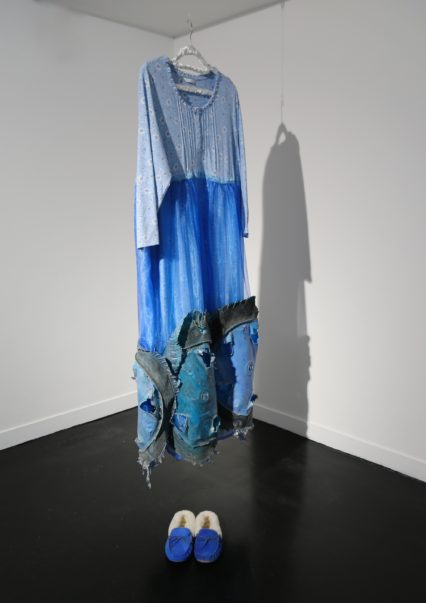 Similar hues work through the fabrication of the costume of Walking Mum. The outer garment, a long trail and stole are grand and evokes a formal event, the church, status, ritual, wedding and celebration. The rich high lustre celestial blue is regal with swirling tree, branch and thorn elements floating and climbing across its surface. Latex moulds of pots and pans hang at intervals from the trail piece as attributes of the everyday. Their silence is poignant. The richness of this piece is contrasted with the undergarment work hanging in this installation on the other side of Mum’s bedding. Here, a light blue patterned upper garment, with cobalt blue dress and two knee to floor latex and rubber wheels. Symbols of mobility yet also here perhaps, referencing kneeling both in terms of religious and domestic roles. Both of these costume works were integral to Wanda Zyborska’s performance in Walking Mum. Lasting about nine minutes Walking Mum is a commanding manifestation of a paradox of action. Focused and unfocused actions of putting on outer garments, interacting with Anger Pantry, the audience and the piano in the main Galeri space, the work features Zyborska’s characterisation of an identity suffering under Alzheimer’s disease. It is at once charming, elegant and distant; repetitive movements of pacing and walking then stopping means we have to keep up with the unexpected. However, it is through Zyborska’s subtle expressive movement and commanding expression that our gaze is transported to another place.
Similar hues work through the fabrication of the costume of Walking Mum. The outer garment, a long trail and stole are grand and evokes a formal event, the church, status, ritual, wedding and celebration. The rich high lustre celestial blue is regal with swirling tree, branch and thorn elements floating and climbing across its surface. Latex moulds of pots and pans hang at intervals from the trail piece as attributes of the everyday. Their silence is poignant. The richness of this piece is contrasted with the undergarment work hanging in this installation on the other side of Mum’s bedding. Here, a light blue patterned upper garment, with cobalt blue dress and two knee to floor latex and rubber wheels. Symbols of mobility yet also here perhaps, referencing kneeling both in terms of religious and domestic roles. Both of these costume works were integral to Wanda Zyborska’s performance in Walking Mum. Lasting about nine minutes Walking Mum is a commanding manifestation of a paradox of action. Focused and unfocused actions of putting on outer garments, interacting with Anger Pantry, the audience and the piano in the main Galeri space, the work features Zyborska’s characterisation of an identity suffering under Alzheimer’s disease. It is at once charming, elegant and distant; repetitive movements of pacing and walking then stopping means we have to keep up with the unexpected. However, it is through Zyborska’s subtle expressive movement and commanding expression that our gaze is transported to another place.
There is a dual aspect to the subject at play in the work. One is the objective reflection on the actions and signifiers of a changing character, whose steadfast mother role is visualised deteriorating into startling and unnerving realms of detachment and the other is memory through narrative. This second aspect of memory is itself multifaceted. Conventionally since Sigmund Freud, mourning involves the severing of recall and thought ties until all strands of reality are dissolved and replaced by a different persona. This re-invention is crucial in the understanding of the transformative process evidenced in the work of this exhibition. Moreover, within the context of more recent analysis, Judith Butler would assert that the mourners themselves start to question who they are without the other. This is less one dimensional than Freud’s interpretation perhaps; the effect of Alzheimer’s disease with its sense of loss akin to mourning, impacts on those experiencing (the self) as well as the sufferer (the other), so the self is defined through a sense of both, an inextricable link between two. This autobiographical aspect to the work moves the experience from monumental or memorial to a state of reinvention of the self; representing the tie between mourner and lost but also a redefinition of identity through the other. Herein lies the capability for expressive goal that is more than achieved in this exhibition and the manifestation is highly engaging in its narrative.
The narrative content is one of memory. The memory of mother throughout life, in roles domestic, formal and recreational. The strands of the exhibition are subject recollections of memory, interdependent to create a narrative form. The exhibitions narrative expression is not linear, moreover it is multi-faceted and has many strands; it refers to a succession of activities and situations, some recalling the actions in life, like driving or washing and also later, with the onset of the disease, the disturbing actions of an increasingly distant character. As Gerard Genette states, this succession of real events, actions and situations are understood through their totality as narrative content.
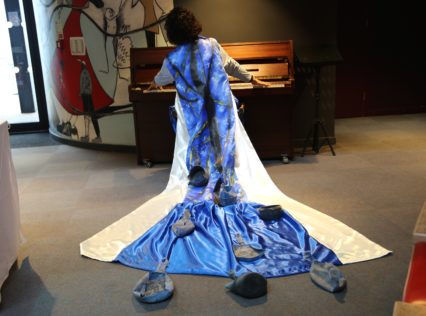
Sound work mumMAM is a collaborative work with Huw McGregor. It is a haunting work of humming voice and piano making an engaging encounter with spatial form through metaphorical reference to Elgar, the Welsh National Anthem, footsteps (pacing), birdsong (nature), bells (church) and crockery (domestic). Lasting approximately eight minutes the work is deeply evocative and immersive and heightens our perceptions of all spaces utilized for the exhibition and the subjective territories of place and memory. In activating the spaces, it threads its own way through the viewers’ sensory memory to linger and fuse with the other areas and works in the exhibition. The combination of sonic expressions is considered and measured, defining a rich narrative and echoing the subject of memory, in so much that some strands or elements are focused whilst others fade.
Finally, to return to the subject of medium in the work. For Acheson-Elmassry, in this exhibition and for work to date, the signature medium as a sculptor is part to do with the combination of materials into made form and part direct moulding from an object. The medium is essential and specific to meaning. Medium is more than intermediate agency, instrument or channel; rather, its intrinsic composition, quality and state are fundamental features and intrinsic to the meaning in the work. Acheson-Elmassry’s use of latex is as a moveable, pliable substance with liquidity that as sculptural form has the capability to both describe object, reconfigure the form and activate space or location in a multifaceted and non-rigid or pliable way. Moreover, it is alchemical and acts as a vehicle for pigment and texture allowing in an almost painterly fashion, the mixing intrinsically in preparation and later addition (possibly, but not necessarily) of further colour after the initial moulding. It is a hybrid methodology built on the paradigm of established method that has reflexivity.
The rich tableaux of varied specific medium at work in the strands of this exhibition include video projection and screen, sound, performance, installation, sculpture and textiles each interlinking in a matrix of process intersections. Inherently, this aspect of the multiple process and medium application is, in itself metaphorical for the strands of memory that make up the subject, a form of simultaneity. Memories that are incomplete and imperfect, subjective memories evoked from the passing of time, in turn recreating ourselves and reaffirming our own identities of the present.


